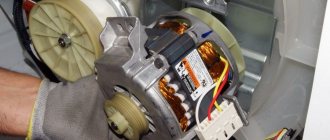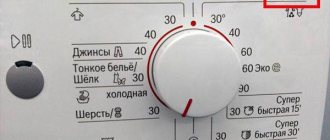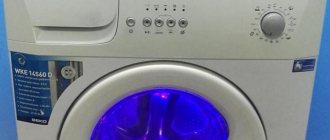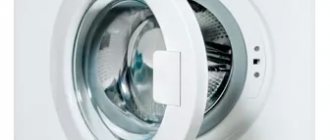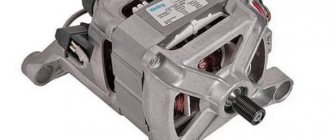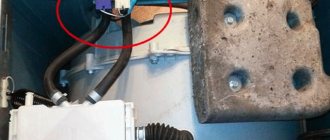A washing machine is a household equipment that every second housewife today cannot do without. Automated washing with a choice of optimal modes for clothes made from different fabrics, spinning, pre-drying - all this reduces daily worries and makes it possible to do other household chores. But what to do if the machine does not turn on or works poorly.
Power is supplied - the machine does not work
Washing machine won't turn on
If the machine suddenly starts to turn on poorly, then you need to find the reason. Don't panic - the answer to the question why the washing machine doesn't wash may be on the surface. The main problems and their causes are presented in the following table:
| Signs | Causes |
| Doesn't turn on | No power supply: – the automatic fuse on the socket line has switched off; – if there is an extension cord, it is faulty; – the plug is not plugged into the socket. |
| The power light is on, but the machine does not work | – the loading hatch lid is not tightly closed; – water does not flow into the tank; – violation of the order of inclusion; – a delayed work program has been installed. |
| The water fill cycle does not occur | Water supply interrupted: – the water supply tap is closed; – bend of the water hose; – water pressure is below the permissible norm; – “Pause” mode was accidentally turned on. |
| The washing machine does not wash, but there is a continuous cycle of pumping and draining water | – the inlet hose is installed incorrectly; – the drain is in water. |
| The mode for draining dirty water and spinning does not turn on | – the drain pipe is clogged; – the hose is bent; – a mode is set that does not allow spinning of washed items. |
| Vibration during spin cycle | The machine does not work well due to equipment installation errors: – the first start was made without unlocking the drum; – the machine is installed with the horizon obstructed; – the length of the support legs is not adjusted. |
| Water leaks | – poor fastening of the drain or filler pipe; – The detergent dispenser is clogged. |
Attention! In circumstances where none of the reasons presented in the table have been established, and additional turning off and on does not produce results, you should disconnect the machine from the network and contact the service center specialists.
Before calling the specialist
First, try to carry out simple diagnostics yourself to make sure that the problem is a malfunction of the machine itself:
- First of all, you should make sure that the machine is connected to the network. If everything is in order, but it still does not turn on, make sure that there is current in the network. Voltage fluctuations can lead to a malfunction of the outlet, and the one in which the machine is plugged in. To make sure there is voltage, try connecting another electrical appliance to the same outlet.
- Check that the plug and the cord itself are in good condition and free of damage. If everything is fine with the power supply, but the washing machine still does not turn on, then you should look for a fault in the device itself. Carefully inspect the surface of the plug and cord. Make sure there is no burning on them and no unpleasant smell of burning plastic. If such damage is discovered, you should not reconnect the machine to the network. The malfunction in this case will consist of damage to the wire, and to solve the problem it is enough to replace it.
If everything is in order with the cord, plug and socket, then the fault is probably in the internal technical components of the device and this cannot be done without the help of a professional.
The machine doesn't wash well
When you find things that are not clean enough after washing, the question usually arises as to why the washing machine does not wash well for no apparent reason. The reasons for poor quality removal of stains and dirt from laundry by a washing machine, provided that it is installed correctly and started for the first time, are presented as follows:
- Water quality. In apartment buildings, water supply to the sanitary areas of apartments is carried out through common pipelines. If one of the neighbors in the “riser” changed pipes or installed equipment, then there is a high probability that rust and sediment “went” lower, getting into the water supply in the machine, therefore, it does not wash things well. The problem is solved by draining to clean water.
- The machine does not wash well due to the washing powder. Purchasing cheap washing powders from unknown brands is one of the reasons for poor quality washing. Excessive foaming can occur when using hand washing powder or significantly exceeding the dosage for one wash, which does not guarantee a quality result. Why sometimes branded powder does not wash well - the possibility of purchasing counterfeit products cannot be ruled out.
Consequences of using hand washing powder - Faulty water heater. Failure of the heating element leads to the fact that the washing machine does not wash well with cold water. If clothing is significantly soiled, it is impossible to obtain the desired result.
- Another reason why the washing machine does not wash well may be a malfunction of the drum drive. It may rotate intermittently or slowly due to critical wear of the bearings or a stretched belt. If these malfunctions are detected, you must stop operating the washing machine immediately and contact the nearest service center for help.
Attention! It is impossible to remove individual stains from clothing without the use of special cleaning compounds by simply washing them in a machine. If the washing machine does not wash things, then you should pre-treat it with a stain remover, and then wash it again.
Problem No. 4 - heating element malfunction
A malfunction of the heating element affects the cycle duration for the following reason: if a malfunction occurs, more time is spent to achieve the desired water temperature. Accordingly, the washing machine takes a long time to wash. Depending on how serious the defect has occurred in the system, one wash may take not 40 standard minutes, but up to 2 or more hours.
Solution
There is only one way out of this situation - replacing the faulty part. You can do this yourself if you have the skills to carry out such work. If you are not confident in your abilities, it is better not to take risks and call a qualified technician.
Preventive actions
Compliance with the manufacturer's technical recommendations for installation, initial start-up and maintenance of the washing machine reduces the likelihood of low-quality washing:
- installation on a flat plane with uniform distribution on all support legs will eliminate vibration;
- interruptions in the water supply due to kinking of the hoses will prevent the correct connection of the water input and drainage;
- correct connection to the electrical network, through an automatic fuse, with mandatory grounding, will prevent electric shock;
- installing a cleaning filter at the entrance to the water supply system will prevent the penetration of rust and impurities;
- Periodically cleaning the washing machine filter will ensure sufficient pressure and eliminate heavy particles;
- high-quality powder will create an active environment for removing stains, and the use of conditioner will give freshness to clean clothes;
- preliminary determination of the origin of stains will allow timely use of special cleaning compounds;
- Periodic use of cleaning agents for the heating elements of the machine will eliminate scale deposits.
Scale on the heating element
Attention! If indirect signs of a malfunction of the washing machine are detected, it should be turned off: remove the plug from the power outlet and turn off the water supply. If the malfunction was reflected on the machine display with an alphanumeric designation, then this code must be reported when contacting the service.
The presented video shows the procedure for diagnosing a household washing machine:
Familiarization with what to do if the washing machine does not turn on or refuses to wash properly will prevent housewives from panicking. Following simple recommendations will allow you to determine the cause and, if necessary, seek outside help.
Precautionary measures
To prevent the causes of breakdowns of this nature, you need to follow several recommendations from experts:
- It is necessary to install a tap that regulates the amount of incoming liquid. Its presence allows you to extend the life of the intake valve.
- Additionally, a siphon valve is installed - a device that prevents sewage water from entering the appliance drum during washing.
- Before draining the washing machine, you need to make sure that the settings on the control panel have been selected correctly.
- To prevent the machine from drawing water on its own when it is turned off, you need to secure a leakage protection system to the floor - this will extend the service life of the equipment.
In conclusion, I would like to add that despite the independent actions of your main assistants when washing things, you should not leave them unattended while working.
Modern units are also equipped with timers to delay the turn-on time of devices, but you should not trust them again, and not because of their unreliability; a short-term power surge, for example, during a lightning strike, can also cause a breakdown.
How to replace the heating element of a washing machine yourself?
In almost all modern models, the heating element is located under the drum in the rear. On some models, the heater may be located at the front. The replacement process itself will differ only by removing the front cover instead of the back.
To check and successfully replace the heater you must:
- Remove the back cover.
- Check the heating element using a multimeter. The contacts of the device are applied to the heater outputs. If the sensor shows infinity, then the heating element has failed. The reason for this was scale, oxidation or burnt contacts.
- The temperature sensor and all attached wires must be disconnected from the heater. If the temperature sensor is working, then it does not need to be changed.
- In most models, the heating element is screwed in with a nut of 8 or 10. Having unscrewed it, you need to pry the heater off from all sides one by one. For this task it is convenient to use a regular flathead screwdriver.
- The most difficult thing, when removing the heater, is to insert the rubber pad through the hole. After this, you can attach a new heating element. It is important to lubricate the rubber pad before installing it. You can use the most common dish soap as a lubricant. It will make the elastic slip and make insertion easier.
How to replace the control module of a washing machine with your own hands?
In order to remove and replace the control module of the washing machine you need:
- Pull out the tray by gently pressing the plastic latch.
- Unscrew the screws located behind the tray. It is also worth unscrewing the bolt located at the back of the control unit.
- After that, the front top cover is removed, on which the main controls are attached. You can also check the integrity of the mode switch on it.
- The panel is held on by plastic latches; they must be carefully removed using a flat-head screwdriver.
- The wires do not need to be disconnected; they are long enough to place the board on the body of the washing machine and replace it.
- A rubber pad sticking out from under the tank will get in the way. There is no need to put in a lot of effort and drag out the fee. To do this, the edge of the seal is bent and the rubber clamp is removed.
- Then unscrew the 2 bolts from the hatch lock and disconnect it from the board.
- By unscrewing the lower and upper screws of the base panel, you can remove the main board.
It must be completely inspected for burnt-out elements. If there are few burnt areas, it will be much more profitable to pay for repairs to a service center. If a large part is burned out, then repair is impractical and may cost more than replacement. You can buy a new control module in specialized stores. When purchasing, it is important that it is already programmed, otherwise they will get tired of paying extra for setting it up. Replacing the control module of a washing machine can be done according to the instructions described above, only in reverse order. It is important to remember the wire connection locations before connecting a new board.
How can I avoid problems with switching washing modes in the future?
To prevent the washing machine from starting to switch modes poorly again after the replacement, you must adhere to the following operating rules:
- When washing with hard water, be sure to use products that reduce its hardness. If this is not done, scale will form, and it will gradually destroy the heating element.
- For each type of thing you need to select the appropriate mode.
- Before placing items in the drum, they must be sorted by the material from which the fabric is made. However, you should not exceed the permissible weight.
- Use only reliable detergents.
- Approximately once every 3-4 months it is necessary to clean the heating element from oxidation using regular citric acid or specialized products. This way you can significantly extend the life cycle of the heater.
